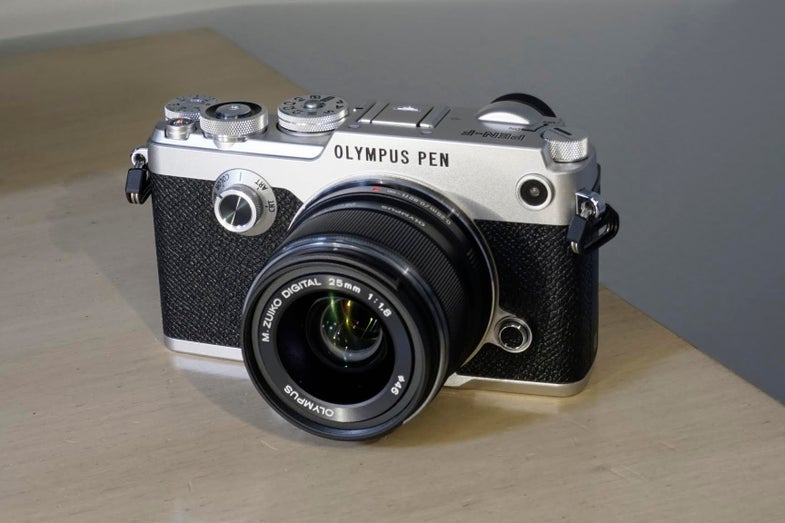Hands On with the Olympus Pen-F Camera
We spent a couple of days with Olympus’s new Pen-F

We may earn revenue from the products available on this page and participate in affiliate programs. Learn more ›















[NOTE: To see the full-resolution sample images, check out this Flickr gallery.]
In the July 1963 issue of Popular Photography senior editor Norman Rothschild wrote about his experience using the newly announced Olympus Pen-F while in Cologne, Germany for the Photokina tradeshow. It was the world’s first half-frame 35mm body, making vertical images that were approximately half the width of a horizontal 35mm frame. As a result, it produced vertically oriented images when the camera was held in its regular horizontal orientation. While Olympus didn’t opt to rotate the sensor in the new digital Pen-F, the main idea behind the two cameras remains the same: Make a camera that is easy and fun to use while being small enough that you won’t mind bringing it along with you wherever you go. And the price of the new Pen-F, at $1,200, isn’t all that much more than the $917.50 that the original $120 price becomes when adjusted for inflation. I had the opportunity to use an early sample of the Pen-F in Austin, TX on a junket that Olympus arranged.
The Pen-F is the first Olympus digital camera in the Pen series to have a built-in viewfinder, which shows that the company is aiming for shooters who want a higher level of shooting experience than a finderless camera can provide. The Olympus representatives we spoke with said that they hope street shooters will cotton to the camera’s comfortable control system, small size, and speedy AF. In our time with the camera, we mainly shot with prime lenses, especially the 17mm f/1.8, 25mm f/1.8 and 45mm f/1.8. Those lenses, were able to focus quite fast, as did the zoom lenses we shot with only briefly. While older zoom lenses had a tendency to slow down AF thanks to the large glass element that they had to move in order to focus, most of Olympus’s Micro Four Thirds lenses use smaller focusing groups to keep the focusing pleasingly zippy. Street shooters who actually use AF (both of you please raise your hands) should be pleased.

The shutter release button is embedded within the front command wheel to save space, but more importantly, it has a socket for an inexpensive, screw-in cable release. Again, this can be seen as a nod to some street shooters who use a cable release to remain less noticeable when out shooting. It also makes for an easy way to trigger longer exposures, or the High Res shot mode that shoots 8 images as the sensor shift stabilization mechanism moves the sensor and combines them into one in order to increase the resolution in the resulting file. You can make 80MP images from RAW files in this way, but you’ll want to stabilize the camera on a tripod and shoot a subject that also isn’t moving as the camera captures the 8 frame burst. If you want a JPG from HIgh Res mode, you’ll get a 50MP file.
If you’re a fan of shooting with vintage glass through adapters, or any fully manual lenses that don’t communicate with the body, you’ll appreciate that the Pen-F lets you make a list of the lenses that the camera can’t identify. It’s a slightly laborious task to enter the names of the lenses, but once you do, you can select them from the list in the body and the camera will include the name of the lens in the EXIF data. It may seem like a little thing, but if you’ve shot a lot of images with multiple such lenses over the course of a weekend while switching among a handful of them, it’s a really helpful thing to have when sorting out which images were shot with which lens.
Overall, the camera has a classic look that is very appealing. The on/off switch is a round knob on the left side of the camera top and reminds me of the a slightly smaller version of the film rewind knob on very old Leica cameras. In fact, most of the controls on the Pen-F are round. According to Olympus that’s partially because, in the time that the original Pen-F was made, it was less expensive to mill round pieces than it was to make square metal parts. So, in homage to that, the new Pen-F has a round EVF eyecup. We’re not sure if it’s just a quirk of early samples, or the shape of the rubber on the eyecup, but on a few occasions, the sensor that recognizes when you hold the camera up to your eye didn’t work properly, thus not switching to the EVF. You can work around this by manually switching ot the EVF, but it was a tad annoying when it did happen.
A small exposure compensation dial on the right side of the camera top lets you adjust up to +/-3 EV and if that’s not enough you can use one of the command wheels to reach up to +/- 5 EV. If the dedicated dial is enough, you gain the option of assigning something else to the command wheel and it is freed up to be able to control other things, such as highlight and shadow detail in custom color and monochrome modes.

Speaking of those modes, the dial on the front of the camera body, evoking the shutter speed control dial on the original Pen-F, lets you switch between Art Filters, Color Creator, Color Profile Control, and Monochrome Profile Control modes. Each of the profile control modes has three different settings and each of those can be customized. Those modes also add grain to the images. However, Olympus says that it’s not just a blanket of fake grain. Instead the caemra takes into account the content of the image and aplies grain differently in different areas to better approximate what film grain would actually look like. I left the grain settings on their default for my shooting. You can also add vignetting, though for the most part, I didn’t employ this option and its default setting is off.
The Color Profile modes include standard (similar to normal color shooting), chrome rich color, and chrome film vivid modes. Monochrome Profile modes include, standard (similar to normal monochrome shooting), high contrast, and infrared simulation modes. The infrared simulation doesn’t engage an actual infrared shooting mode, but does a nice job of giving that kind of look, with greens turning brighter and clear skies turning darker as they would with real infrared shooting.
While these color and monochrome modes might sound kitschy at first, in practice they’re quite enjoyable and offer enough customization to tailor them to your taste and incorporate them into your shooting when the moment strikes you. Since the dial is very accessible, I found myself switching through them a lot and having a very fun time. If you shoot RAW+JPG, as I do, you can always go back and second guess yourself if you think that you made the wrong decision in the moment.
Overall, the Pen-F proved a very comfortable camera to use. If you like street photography, or just want a powerful, small camera, it deserves your serious consideration.
Speaking of those modes, the dial on the front of the camera body, evoking the shutter speed control dial on the original Pen-F, lets you switch between Art Filters, Color Creator, Color Profile Control, and Monochrome Profile Control modes. Each of the profile control modes has three different settings and each of those can be customized. Those modes also add grain to the images. However, Olympus says that it’s not just a blanket of fake grain. Instead the caemra takes into account the content of the image and aplies grain differently in different areas to better approximate what film grain would actually look like. I left the grain settings on their default for my shooting. You can also add vignetting, though for the most part, I didn’t employ this option and its default setting is off.
The Color Profile modes include standard (similar to normal color shooting), chrome rich color, and chrome film vivid modes. Monochrome Profile modes include, standard (similar to normal monochrome shooting), high contrast, and infrared simulation modes. The infrared simulation doesn’t engage an actual infrared shooting mode, but does a nice job of giving that kind of look, with greens turning brighter and clear skies turning darker as they would with real infrared shooting.
While these color and monochrome modes might sound kitschy at first, in practice they’re quite enjoyable and offer enough customization to tailor them to your taste and incorporate them into your shooting when the moment strikes you. Since the dial is very accessible, I found myself switching through them a lot and having a very fun time. If you shoot RAW+JPG, as I do, you can always go back and second guess yourself if you think that you made the wrong decision in the moment.
Overall, the Pen-F proved a very comfortable camera to use. If you like street photography, or just want a powerful, small camera, it deserves your serious consideration.